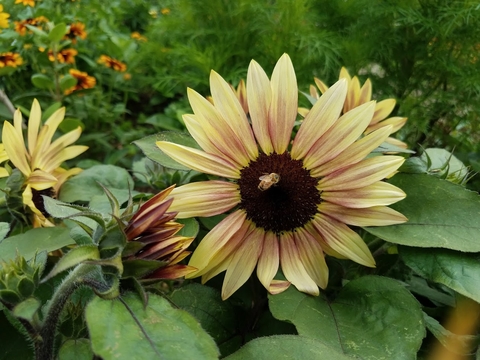Quick facts
- The sunflower is an easy, fast-growing flower and can be a fun addition to your garden.
- Sunflowers are not just yellow, they come in a variety of colors from pale white to deep red.
- Sunflowers are simple to start from seed and can be planted in succession to have season-long color.
Sunflowers (Helianthus annuus) are an annual plant that is very popular in Minnesota gardens. Native to North America, sunflowers have been used for over a thousand years as ornamental plants and harvested for seeds, oil and dyes.
Whether you want to grow sunflowers to add color to your garden, to use as a natural child’s playhouse or to include in bouquets and arrangements, there is a sunflower for you.
Starting sunflowers from seed
Sunflowers are one of the easiest flowers to start from seed. The seed is large and easily handled, and you can direct seed into the garden, or germinate indoors and plant in the garden once true leaves have formed. Whichever way you choose, the cultivation of the sunflower is the same.
Light
Sunflowers enjoy full sun.
Soil
- Sunflowers generally grow best on well-drained soils.
- They are tolerant of clay loam or silty clay loam soils, and perform well on sandy loam soils.
- Sunflowers do best when grown in slightly acidic soil with a pH from 6.0 to 6.8.
- Prior to planting, it is best to use a soil test to determine your soil’s nutritional needs.
Planting
Direct seeding
- Direct seed sunflowers after all danger of frost has passed.
- Plant seeds one inch deep.
- For varieties that are 2-5 feet tall, leave about 6 inches between them.
- Space taller sunflowers at least 1’ apart and giant sunflowers 2’ apart.
- Seeds germinate within 7-10 days.
Starting sunflowers indoors
- Sow seeds indoors in biodegradable containers.
- This will allow you to plant the entire pot without disturbing the seedling roots.
- Remove any part of the container that sticks above the soil surface as it will act like a “wick” and dry out the roots.
Succession planting
You can have sunflowers blooming all season long through succession planting. There are three ways of doing this:
- Plant multiple varieties that have different days to maturity all at one time.
- Plant the same variety at one- to two-week intervals.
- Plant multiple varieties with varying days to maturity at three- to four-week intervals.
Sunflower varieties
Branching cultivars get quite large and produce an abundance of blooms over a long period.
They require a good deal of room, so space them 18 to 24 inches apart.
Cultivars of branching sunflowers include:
- 'Sonja'
- 'The Joker'
- 'Shock ‘O Lat'
- 'Teddy Bear'
Pollenless cultivars are used primarily as cut flowers or garden plants. Pollen-free types do not contain any of the bright yellow pollen that can stain clothing.
Heights range from two to eight feet with a variety of flower colors and forms.
Cultivars of pollenless sunflowers include:
- 'ProCut Series'
- 'Double Quick'
- 'Sunrich'
Dwarf cultivars are three feet tall or less. They generally work well in front of beds or borders, in limited spaces or in containers.
Cultivars of dwarf types include:
- 'Teddy Bear'
- 'Sunspot'
- 'Ms. Mars'
Semi-dwarf cultivars are between three to eight feet tall and usually do not require staking. These cultivars generally work well in the beds or borders of most home landscapes.
Cultivars of semi-dwarf sunflowers include:
- 'Cappuccino'
- 'Chianti'
- 'Italian White'
- 'Moulin Rouge'
Giant cultivars grow to a height of eight feet or more. These cultivars sometimes require staking due to the size of the plants, flowers and seed heads.
Space plants about two feet apart for good air-circulation.
Cultivars of giant sunflowers include:
- 'Cyclops'
- 'Mammoth Russian'
- 'American Giant'
Maintenance
Watering
Sunflowers can withstand some drought. Water them regularly 20 days before and after flowering to encourage root growth, which is helpful with taller sunflower varieties bearing top-heavy blooms.
Fertilizing
A side dressing of an all-purpose slow release fertilizer applied when the sunflowers have several true leaves will speed growth and produce larger flowers.
Weeds
Control weeds by tilling, hoeing or mulching.
How to keep your sunflowers healthy
While sunflowers are relatively easy to grow, they have a few potential pests, such as wildlife and insects.
Birds
Scare tactics such as spinners, scarecrows and owl decoys may be effective in deterring birds from eating the seeds until it is time to harvest.
Deer
Deer can destroy young, developing plants quickly. If deer have access to your sunflowers, repellents or fencing may be necessary.
If you decide to use an insecticide to control pests, remember that sunflowers also attract an enormous number of beneficial insects and pollinators.
Some common insect pests are:
Stink bugs
Stink bugs have piercing and sucking mouthparts that can cause extensive damage to ornamental plants and crops.
Aphids
Aphids are very common insects and are found on most plants in yards and gardens. Aphids use slender needle-like mouthparts to feed on sap from plants.
They also excrete honeydew, which can be a sticky mess and encourage the growth of sooty mold.
Caterpillars
Caterpillars have chewing mouthparts and can be voracious eaters of leaves and flower petals.
CAUTION: Mention of an insecticide or use of an insecticide label is for educational purposes only. Always follow the insecticide label directions attached to the insecticide container you are using. Remember, the label is the law.
Fungal infections are occasionally found on the leaves of sunflowers, typically affecting the oldest leaves first. If the plants are old enough and have vigor, they can normally grow despite these diseases.
Reviewed in 2024





